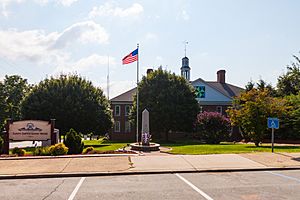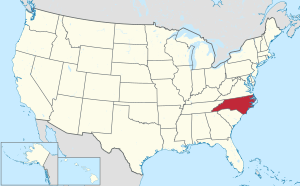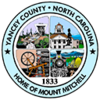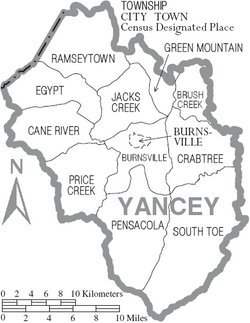Yancey County, North Carolina facts for kids
Quick facts for kids
Yancey County
|
||
|---|---|---|

Yancey County Courthouse
|
||
|
||

Location within the U.S. state of North Carolina
|
||
 North Carolina's location within the U.S. |
||
| Country | ||
| State | ||
| Founded | 1833 | |
| Named for | Bartlett Yancey | |
| Seat | Burnsville | |
| Largest community | Burnsville | |
| Area | ||
| • Total | 313.18 sq mi (811.1 km2) | |
| • Land | 312.59 sq mi (809.6 km2) | |
| • Water | 0.59 sq mi (1.5 km2) 0.19% | |
| Population
(2020)
|
||
| • Total | 18,470 | |
| • Estimate
(2023)
|
18,938 | |
| • Density | 59.09/sq mi (22.81/km2) | |
| Time zone | UTC−5 (Eastern) | |
| • Summer (DST) | UTC−4 (EDT) | |
| Congressional district | 11th | |
Yancey County is a county located in the U.S. state of North Carolina. As of the 2020 census, the population was 18,470. Its county seat is Burnsville.
History
The area of Yancey County was inhabited by the Cherokee prior to European settlement, as was much of the southern Appalachian region.
Independent and sturdy Scottish, English, and Scotch-Irish and Irish settlers of the Carolina frontier had crossed the Blue Ridge Mountains and settled the Toe River Valley by the mid-18th century. In the year 1796, one of the early land speculators, John Gray Blount, paid for 326,640 acres (1,321.9 km2) of land, a portion of which later became Yancey County.
In December 1833, the General Assembly established a new western county, named Yancey, from sections of Burke and Buncombe counties. Yancey County was named in honor of Bartlett Yancey, of Caswell County. As a U.S. congressman (1813–1817) and as Speaker of the N.C. Senate (1817–1827), he was instrumental in many accomplishments that benefited the state, including the creation of an education fund that was the beginning of the N.C. Public School System. He was an advocate of correcting the inequality in representation in the General Assembly by the creation of new western counties; but he died on August 30, 1828, over five years before the General Assembly created a new county named in his honor. In Yancey's boundaries looms Mount Mitchell, the highest peak in the Eastern U.S., at 6,684 feet (2,037 m) above sea level.
On March 6, 1834, "Yellow Jacket" John Bailey conveyed 100 acres (0.40 km2) of land for the county seat. John was given the nickname for his famous temper as told in the books The Bailey Family of Yancey County, North Carolina and Heritage of the Tow River Valley by Lloyd Richard Bailey Sr. The town was named Burnsville in honor of Captain Otway Burns, who voted for the creation of the new western county when he was serving in the General Assembly. He was also a naval hero in the War of 1812. A statue of Captain Burns stands on a 40-ton, Mount Airy granite pedestal in the center of the town's public square, which was given the official name of "Bailey Square" by the Yancey County Board of Commissioners on September 1, 1930. The statue of Captain Burns was given to the county on July 5, 1909, by Walter Francis Burns, a grandson of the naval captain. The inscription reads:
Otway Burns - Born in Onslow County, North Carolina, 1777 - Died at Portsmouth, North Carolina, 1850. Sailor - Soldier - Statesman. North Carolina's Foremost Son in the War of 1812-1815 - For Him, This Town Is Named - He Guarded Well Our Seas, Let Our Mountains Honor Him.
Geography
According to the U.S. Census Bureau, the county has a total area of 313.18 square miles (811.1 km2), of which 312.59 square miles (809.6 km2) is land and 0.59 square miles (1.5 km2) (0.19%) is water. Mount Mitchell at 6,684 feet (2,037 m), within Mount Mitchell State Park in Yancey County, is the highest point in the United States east of the Mississippi River. The Black Mountains, of which Mt. Mitchell is a part, contains five of the 10 highest peaks east of the Mississippi, all over 6,400 ft (2,000 m). In descending order of height, they are: Mount Mitchell, Mount Craig, Balsam Cone, Mount Gibbes, and Potato Hill.
National protected areas
- Blue Ridge Parkway (part)
- Crabtree Falls (part)
- Pisgah National Forest (part)
State and local protected areas/sites
- Bare Dark Sky Observatory
- Carolina Hemlocks Recreation Area
- John Wesley McElroy House
- Mount Mitchell State Park
- Nu-Wray Inn
- Pisgah National Forest Game Land (part)
- Ray-Cort Recreation Park
Major water bodies
- Big Crabtree Creek
- Big Creek
- Bowlens Creek
- Cane River
- Left Prong South Toe River
- Nolichucky River
- Right Prong South Toe River
- South Toe River
- Still Fork Creek
Adjacent counties
- Mitchell County – northeast
- McDowell County – southeast
- Buncombe County – southwest
- Madison County – west
- Unicoi County, Tennessee – northwest
Major highways
 US 19
US 19 US 19E
US 19E US 19W
US 19W NC 80
NC 80 NC 128
NC 128 NC 197
NC 197
Demographics
| Historical population | |||
|---|---|---|---|
| Census | Pop. | %± | |
| 1840 | 5,962 | — | |
| 1850 | 8,205 | 37.6% | |
| 1860 | 8,655 | 5.5% | |
| 1870 | 5,909 | −31.7% | |
| 1880 | 7,694 | 30.2% | |
| 1890 | 9,490 | 23.3% | |
| 1900 | 11,464 | 20.8% | |
| 1910 | 12,072 | 5.3% | |
| 1920 | 15,093 | 25.0% | |
| 1930 | 14,486 | −4.0% | |
| 1940 | 17,202 | 18.7% | |
| 1950 | 16,306 | −5.2% | |
| 1960 | 14,008 | −14.1% | |
| 1970 | 12,629 | −9.8% | |
| 1980 | 14,934 | 18.3% | |
| 1990 | 15,419 | 3.2% | |
| 2000 | 17,774 | 15.3% | |
| 2010 | 17,818 | 0.2% | |
| 2020 | 18,470 | 3.7% | |
| 2023 (est.) | 18,938 | 6.3% | |
| U.S. Decennial Census 1790–1960 1900–1990 1990–2000 2010 2020 |
|||
2020 census
| Race | Number | Percentage |
|---|---|---|
| White (non-Hispanic) | 16,625 | 90.01% |
| Black or African American (non-Hispanic) | 104 | 0.56% |
| Native American | 57 | 0.31% |
| Asian | 40 | 0.22% |
| Pacific Islander | 1 | 0.01% |
| Other/Mixed | 627 | 3.39% |
| Hispanic or Latino | 1,016 | 5.5% |
As of the 2020 census, there were 18,470 people, 7,510 households, and 5,081 families residing in the county.
Ancestry
As of 2015, the largest self-reported ancestry groups in Yancey County were:
| Largest ancestries (2015) | Percent |
|---|---|
| English |
16.4% |
| American |
16.2% |
| German |
15.1% |
| Irish |
12.8% |
| Scottish |
5.8% |
| Scotch-Irish |
4.8% |
| Welsh |
2.0% |
| Dutch |
1.5% |
| French (except Basque) |
1.1% |
| Swedish |
0.9% |
Education
The Yancey County Schools system serves the K-12 public school students of the county. There are five members of the School Board, elected on even years to four year terms. Three seats are elected on presidential/gubernatorial election years, and two on midterm years. In 2017, the NC General Assembly passed a bill, sponsored by Rep. Michele Presnell, to change the YCS board elections from non-partisan to partisan. As of 2023, the partisan makeup of the board is four Republicans and one Democrat. Kathy Amos is the current superintendent.
In 2016, the YCS Board voted to consolidate three elementary schools in the west and north of the county (Bald Creek, Bee Log, and Clearmont) into one school, which was named Blue Ridge. At the time of its closure in 2018, Bee Log Elementary School was the smallest public school in the state with enrollment of 42. Bald Creek and Clearmont closed the following year. Yancey County schools currently consists of the following schools:
Elementary Schools (Grades K–5)
- Blue Ridge Elementary School
- Burnsville Elementary School
- Micaville Elementary School
- South Toe Elementary School
Middle Schools (Grades 6–8)
- Cane River Middle School
- East Yancey Middle School
High School (Grades 9–12)
- Mountain Heritage High School
High school students have the option to enroll in Mayland Early College High School at the main campus of Mayland Community College in Spruce Pine.
There are two private schools in the county: Arthur Morgan School in Celo and Yancey County Christian School in Burnsville.
Higher Education
Mayland Community College serves the Toe River Valley counties of Avery, Mitchell, and Yancey. The main campus is in Spruce Pine, on the Avery-Mitchell line, but the Yancey Learning Center, a satellite campus, is just outside of the Burnsville town limits on the west side.
Library
Avery-Mitchell-Yancey Regional Library (AMY) serves the county, with the Yancey County Public Library branch located in Burnsville in the Yancey Collegiate Institute Historic District.
Communities
Town
- Burnsville (county seat and largest community)
Townships
- Brush Creek
- Burnsville
- Cane River
- Crabtree
- Egypt
- Green Mountain
- Jacks Creek
- Pensacola
- Price's Creek
- Ramseytown
- South Toe
Unincorporated communities
- Bald Creek
- Bent Creek
- Busick
- Cane River
- Celo
- Day Book
- Green Mountain
- Hamrick
- Micaville
- Murchison
- Newdale
- Pensacola
- Ramseytown
- Sioux
- Swiss
- Windom
See also
 In Spanish: Condado de Yancey para niños
In Spanish: Condado de Yancey para niños



